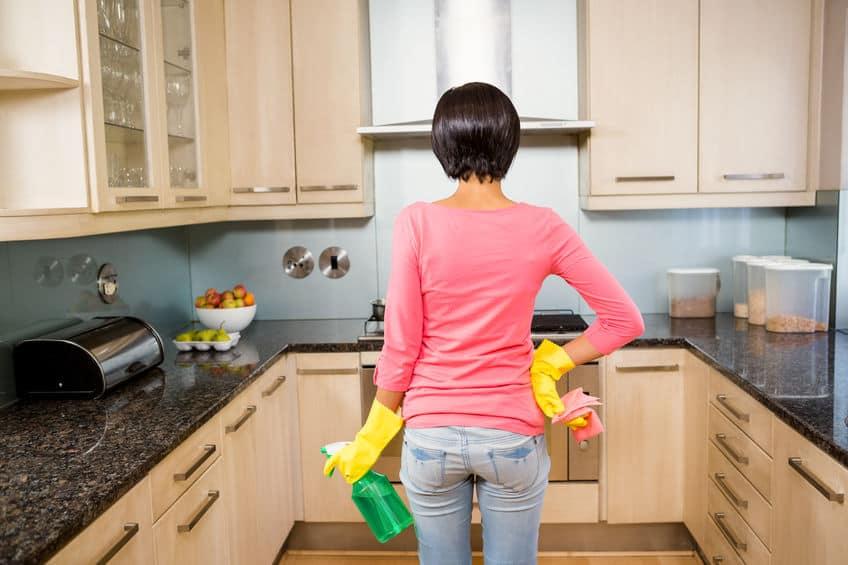Kitchen cabinets are for storing dishes, not grease. Unfortunately, wood cabinets—painted or natural with a clear finish—are prone to all sorts of grease, grime, and gunk from simply being in the kitchen.
- Pickleball Rules – Faults & Dead Balls on the Pickleball Court
- 12 Best Clear Coats for Kitchen Cabinets [Reviews & Buyer’s Guide]
- The 7 Best Garbage Disposals of 2023
- The Ultimate Guide for Cabinet Hardware Placement and Sizing
- Types of Pantry Bugs (With Pictures) – Identification and Treatment Guide

Depending on just how much grease and grime you’re looking at and the supplies you have available, here are four methods to get those cabinets clean and gorgeous. At least one of these will help to get the job done—plus a Bonus for how to keep them looking that way!
Slightly greasy
Vinegar is not just for making pickles and salad dressing. It has amazing grease-busting, cleaning ability, too.
- Dampen a clean, dry cloth with undiluted white vinegar and wipe down greasy cabinets.
- Rinse your cloth with warm water, wring out most of the moisture, and use it to rinse the cabinetry.
- Dry the damp surfaces with a paper towel, noting any still-sticky spots that need a second attempt.
Read more : Kitchen Nightmares: Is the Burger Kitchen still open?
Repeated applications of vinegar may, over time begin to dull the finish. However, occasional use as suggested here, will not be a problem.
Medium greasy, dirty
The cleaning agents in Blue Dawn absorb grease just as well on kitchen surfaces as they do on dishes.
- Add a teaspoon or two Blue Dawn to a bowl of warm water.
- Dip the soft side of a sponge in it. Squeeze the sponge until suds form.
- Apply to the dirty cabinet working on a small area at a time, wiping the grease with the soft sponge until it is removed.
- Immediately dry and buff the surface with a clean cloth to prevent streaking.
Sticky, dirty, gunky
Bust through hardened dingy layers of old, sticky, dust-grabbing grease with vegetable oil and baking soda.
- In a bowl, mix one-part any vegetable oil to two-parts baking soda (example: 1/3 cup oil and 2/3 cup baking soda).
- Apply this oily paste to dirty areas using a soft cloth, paper towel, or your fingers. That ugly, greasy, dirty build-up on the cabinet surface will begin to soften, fall off and begin to disappear.
- Wipe clean and buff with a soft cloth.
Worst case scenario
This is a heavy-duty, industrial-strength solution. Use it on the toughest, most stubborn grease and grime, knowing that depending on the age and condition of that cabinet, it could remove a layer of the finish (which can be reapplied). We’re talking worst case scenario.
- Mix equal parts of paint thinner (not mineral spirits, not lacquer thinner—only paint thinner!) and full-strength Murphy Oil Soap.
- Using a sponge or paintbrush, wipe the solution away with a rag to clear the dirt. You will likely remove a thin layer of varnish or shellac, because the grime may have melded with it.
Considering the alternative of living with the dirty cabinets, I’d go with clean and a slightly modified finish. As always, test first in an inconspicuous place.
Bonus: Wood Polish and Conditioner
Read more : Sendak’s In the Night Kitchen: Unusual History of Censorship by Laura Cattrysse
Following rigorous cleaning, wood cabinets are thirsty for moisture and protection. But you want to be careful that you don’t make matters worse by using something that will create a new kind of build-up that becomes a magnet to kitchen grease and grime!
You won’t find a better product to do that than Howard Feed-n-Wax Wood Polish and Conditioner. It contains beeswax, carnauba wax, and orange oil to keep the wood from drying out, while at the same time repelling kitchen grease. Fantastic for all of the wood surfaces in your home—not only kitchen cabinets.
Updated Re-published 6-11-22
Everyday Cheapskate participates in the Amazon Services LLC Associates Program, an affiliate advertising program designed to provide a means for us to earn from qualifying purchases, at no cost to you.
More from Everyday Cheapskate
Please keep your comments positive, encouraging, helpful, brief, and on-topic in keeping with EC Commenting Guidelines
Caught yourself reading all the way ’til the end? Why not share with a friend.
Source: https://gardencourte.com
Categories: Kitchens

